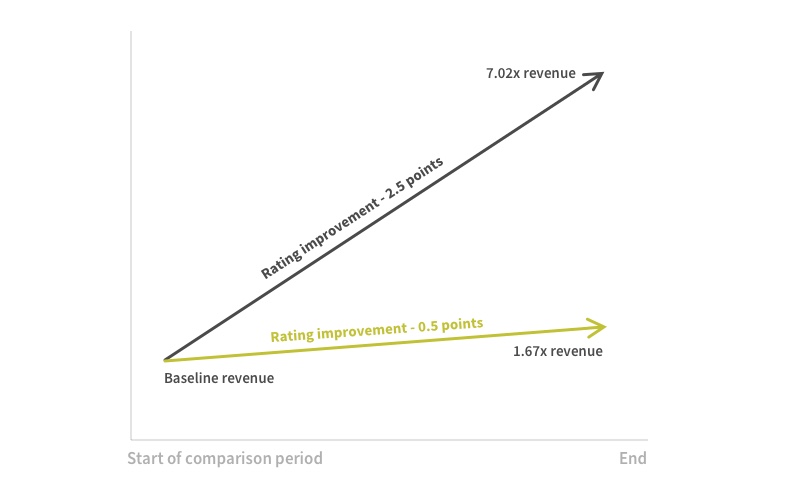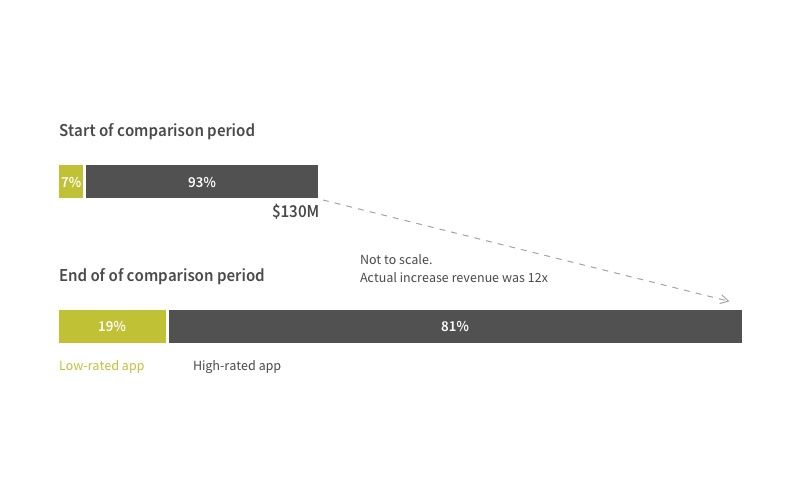
A low mobile app rating leaves money on the table
Higher app store ratings correlate with higher mobile e-commerce revenue.
Consumers pay attention to ratings, and you should too. Ratings are indicative of an item’s quality, and people give bad ratings when they have a terrible experience. In this case study, we explore how to raise your app rating and what effect this has on mobile app revenue. For purposes of this discussion, we refer to mobile apps rated through Apple’s app store for iOS platforms or Google’s app store for Android platforms.
Two apps with different ratings: a perfect comparison
We worked with one Fortune 500 retailer who had two native apps for iOS and Android - one with a high rating (around 4 stars) and another with a low rating (less than 3 stars). We observed the application revenue for both platforms. Typically, mobile apps should account for about 20% of online sales; this retailer’s mobile share was far less.
We compared both the high-rated and low-rated app growth for one year. For the high-rated app, ratings stayed high, and its revenue grew by 1.67x. The low-rated app ratings increased dramatically during the comparison period by over two stars, and its revenue grew by an astonishing 7.02x. The overall ratio of market share between the two platforms remained constant throughout the comparison period.

Next, we compared the ratio of revenue generated through the apps for over four years. In the beginning, the higher-rated app started with a rating of 4.1 stars and brought in 93% of the total mobile app revenue. The lower-rated app began with a rating of 2.4 stars and brought in 7% of the total mobile app revenue. Four years later, the higher-rated app increased to 4.7 stars and brought in 81% of the total mobile app revenue. The lower-rated app jumped up to 4.6 stars and brought in 19% of the total mobile app revenue. This massive jump of the lower-rated app caused a much larger rate of increase in revenue compared to the higher-rated app.

The low-rated app’s technical defects
When approaching the task of fixing the low-rated mobile app, we had to deal with several technical defects. Our first task was to audit the existing code, processes and execution metrics. We observed several issues we identified as candidates for improvement:
- System crashes: The unusually high 5% crash rate caused much consumer frustration. App crashes are a significant problem in many low-rated reviews.
- Poor test coverage: The entire app had less than 50 unit tests and less than 4% code coverage.
- Legacy system architecture: The application was using an outdated MVC (Model-view-controller) architecture.
- Challenging development and maintenance environment: There was no serious consideration that initially given to the development and maintenance processes.
- Dated features: The features of the application were not substantially updated since its initial design many years ago.
Steps we took to improve app ratings
To improve the mobile app ratings, we focused on improving the crash rate and other stability features that were hurting user experiences and causing bad reviews. We did this primarily by implementing quality engineering best practices, like automated testing and deployment, improving the architecture and code quality and adding new features.
- Executed unit testing and system integration testing on both simulators and actual hardware decreased the crash rate. Many issues do not appear on the simulator but are discovered only on target hardware devices.
- Improved auto test coverage: We would add as much automated recursive testing to existing code as possible, and require all new code to have an automated recursive testing capability.
- Modernized the software architecture: We adopted the VIPER (View-interactor-presenter-entity-router) architecture for cleaner, more maintainable code. VIPER is an ideal choice for new software designs.
- Implemented CI/CD: Continuous integration and continuous delivery concepts adopt the idea of automating regression testing, code check-in and deployment.
- Implemented new features: During the redesign phase, we used the opportunity to modernize its features.
The results
Redesign changes resulted in a vastly improved application. Consumers responded by leaving higher app ratings, bringing up the app’s original 2.5-star rating to over 4 stars. The app’s increased ratings also brought in increased revenue growth, as the year over year revenue was up by 4x.
- We dramatically lowered crash rates from 5% (1 in every 20 users) to 0.02% (1 in every 500 users).
- Test coverage increased from 4% to 25%. The new code had over 1,500 unit tests. Test coverage for newly developed code modules was about 85%.
- We adopted the VIPER (View-interactor-presenter-entity-router) architecture for cleaner, more maintainable code.
- We implemented CI/CD and reduced the project release time to less than one hour. This improved total project development time and promised to streamline any future maintenance tasks.
- We implemented many new features, and the total code size grew modestly from 74,000 to 76,000 lines of code.
Conclusion
Mobile applications are now a necessity for retailers, as it can contribute to over 20% of online revenue on regular days and over 30% of online revenue during the holiday season. However, it is not good enough to merely have a mobile presence. Your app must resonate with your customers in quality, features, and shopping experience. Get it right and be rewarded with a high app rating. And a high app rating is rewarded with increased revenue growth.
